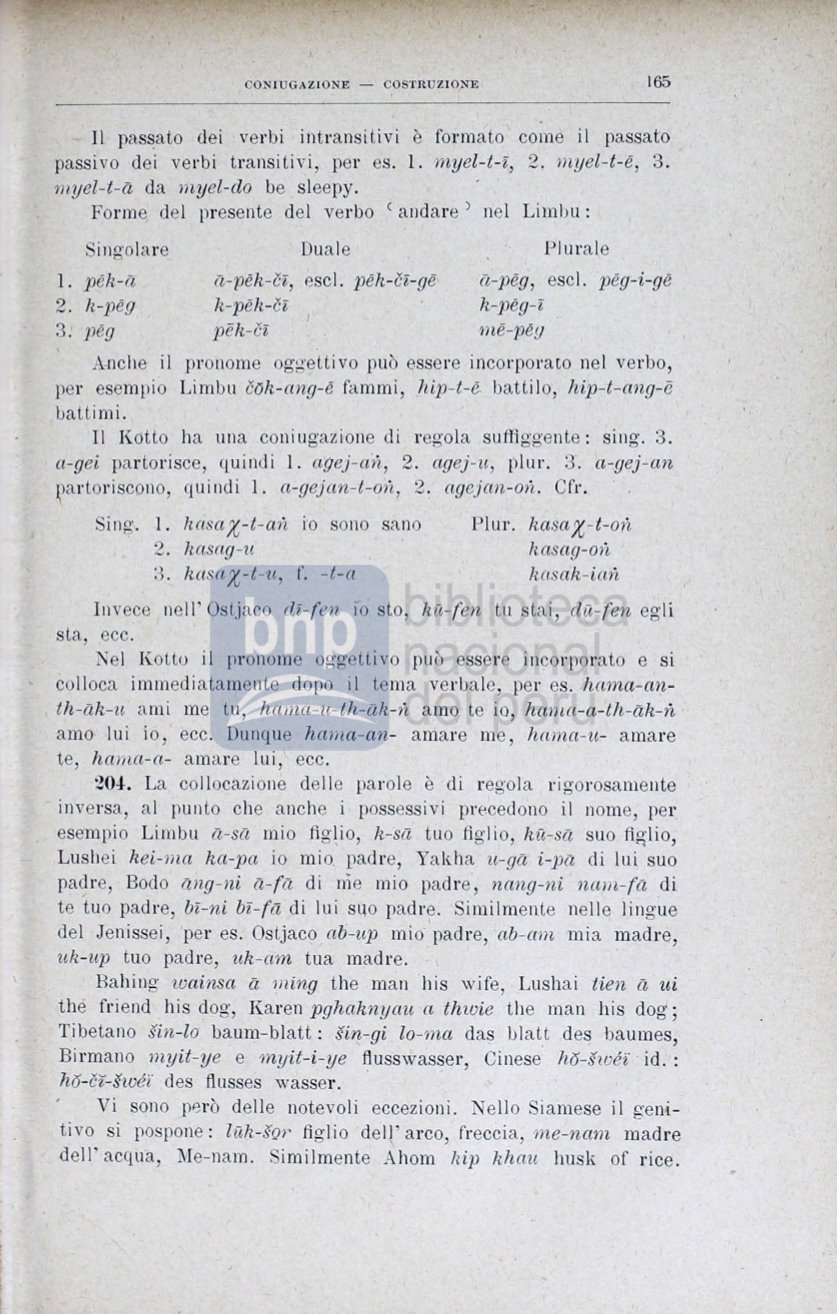

CONIUGAZIONE -
COSTRUZIONE
165
Il
pas~ato
dei verbi intransitivi
e
formato come il passato
passivo dei verbi transi Livi, per es .
l.
niyel-t-i,
2.
myel-t-é,
3.
myel-t-a
da
niyel-clo
be sleepy.
Forme del presente del verbo
<
andare) nel Limbu:
Si1wolare
Dual e
Plurale
1.
pek-a
2.
k-peg
3.
peg
a-pek-ci,
ese!.
pek-ci-ge
k-pek-ci
pek-ci
a-pég,
ese!.
pég-i-gé
k-peg-i
mé-pég
A-nche il pronome oggettivo puo essere inco1·porato nel verbo,
per esemp10 Limbu
cók-ang-é
fammi,
Jiip- t-e.
battilo,
hip-t-ang-e
battimi.
Il Kotto ha una coniugazione di regola suffiggente: sing. 3.
a-gei
partorisce, quindi
l.
agej-a?i,
2.
agej-u,
plur. 3 .
a-gej-an
\)artoriscono, qui ndi
1.
a-gejan-t-01i,
2.
agejan-01i.
Cfr.
ing.
l.
hasax-t-añ
io sono sano
Plur.
kasax-t-01i
2.
kasag-u
kasag-01i
:3 .
ka ax-t-u,
r.
-t-a
kasak-iañ
Invece nell' Ostj co
cl'i/-fe-1
io sto,
kft-fen.
tu sta.i,
Clü-fen
egli
sta, ecc .
el Kotto il pronome
oc:tgetti,~o
pub esser
imcoqw1·ato e si
colloca immediatamente dopo il
tema verbale, per es .
hama-an–
th-ak-u
ami me tu,
h
ZH
- th-ah-ñ
amo te io,
hamá-a-th-t:,;k-ñ
amo lui io, ecc.
unque
hama-an-
amare me,
hama-u-
amare
te,
hama-a-
amare lui, ecc.
204-.
La collocazione delle parole
e
di regola rigorosamente
inversa, al punto che anche
i
possessivi precedono il nome, per
esemp io Limbu
a-sa
mio figlio,
k-sa
tuo figlio,
kü-sa
suo figlio,
Lushei
kei-ma ka-pa
io mio. padre, Yakha
u-ga i-pa
di lui suo
padre, Bodo
ang-ni a-fa
di n1e mio padre,
nang-ni nam-fá
di
te 'tuo padre,
b'i-ni bz-fá
di lui suo padre. Similmente nelle lingue
del Jenissei, 'per es . Ostjaco
ab-up
mio· padre,
ab-ani
mia madre,
uk-up
tuo padre,
uk-am
tua madre.
Bahin°·
wainsa
a
míng
the man his wife, Lushai
Uen
á ui
thé
friend his dog, Karen
pghaknyau a thwie
the man his dog;
Tibetano
sin-lo
baum-blatt:
sín-gi lo-ma
das blatt des baumes,
Birmano
myit-ye
e
myit-i-ye
flusswasser, Cinese'
ho-swéi
id. :
ho-tt-swéi"
des flusses wasser.
Vi sono p13ro delle notevoli eccezioni.
ello Siamese il gen·i-
tivo si po ·pone :
Zük-so1·
figlio del!' arco, freccia,
me-nam
madre
dell' acqua,
íe-narn.
imilmente Ahom
hip klJ,au
husk of rice.
















